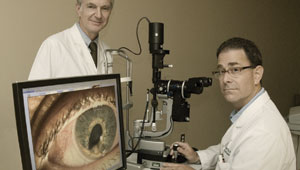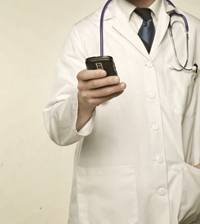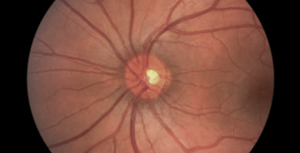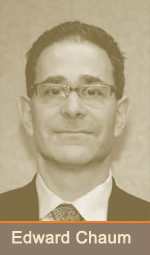By Susan Stewart
What happens when University of Tennessee Health Science Center physicians collaborate with Oak Ridge National Laboratory (ORNL) scientists? The genesis of TRIAD, a novel, computerized assessment of eye disease, is just one example.
Telemedical Retinal Image Analysis and Diagnosis, or TRIAD, was named by R&D Magazine in July 2010 as one of the 100 most technologically significant new products of the year. The low-cost computer-assisted system screens for diabetic retinopathy, the leading cause of blindness in adults.
Invented by Dr. Edward Chaum, TRIAD uses a high-tech camera to enable primary-care physicians to provide eye assessment that was previously reserved for eye specialists. This reduces health care costs, improves patient convenience, and increases the number of patients receiving appropriate eye care.
How TRIAD Began
 The idea for TRIAD began when Chaum had an epiphany during a meeting at ORNL in 2004. The meeting, organized to identify ways the UT Health Science Center could better collaborate with ORNL, quickly met its objective when Chaum heard Ken Tobin, ORNL’s director of measurement science and systems engineering, speak. As Tobin explained his data-processing program that used a library of images to find manufacturer defects in computer chips, Chaum immediately recognized the similarities with his own work in diagnosing eye disease.
The idea for TRIAD began when Chaum had an epiphany during a meeting at ORNL in 2004. The meeting, organized to identify ways the UT Health Science Center could better collaborate with ORNL, quickly met its objective when Chaum heard Ken Tobin, ORNL’s director of measurement science and systems engineering, speak. As Tobin explained his data-processing program that used a library of images to find manufacturer defects in computer chips, Chaum immediately recognized the similarities with his own work in diagnosing eye disease.
“It was an ‘a-ha’ moment,” Chaum says. “Exactly what I do on a subconscious level. Ken and researchers in his field had been teaching computers to do this for years.” Together with Tobin, Chaum soon developed a unique, computerized tool that enables primary-care physicians to provide diagnoses that previously required patients to make a separate trip to the ophthalmologist.
 Helping Diabetics
Helping Diabetics
TRIAD is targeted to diabetic patients, since eye disease often accompanies diabetes. Currently less than half of patients referred to a specialist ever receive such care, even though annual eye exams are essential for diabetics, Chaum says. A separate trip to a specialist is especially difficult for those lacking insurance and income.
“Diabetic eye disease is entirely treatable, if found early enough,” Chaum says. “We (in the U.S.) do a terrible job of diagnosing these patients at the public health level.”
Dr. Scott Morris, family practice physician and executive director at Church Health Center, a community health care provider in Memphis, is helping test TRIAD. Morris says the camera has helped his medical facility provide improved patient care.
“With regard to retinal care for diabetics, we now provide the working poor of Memphis a standard of care equal to the president of the bank,” Morris says.
How It Works
Chaum’s invention enables the primary-care physician to take a digital photo of the retina, which is then scanned and compared with a database of some 12,000 retinal images that Chaum has collected over the years. The computerization process takes just 90 seconds, and includes assigning a rank or degree of eye disease, if disease is present.
Technology is involved not only with how the assessment works, but also with delivery of the computerized assessment. The image and rank are managed via computer or smart phone by Chaum, who confirms or rejects the computerized assessment.
Chaum credits smart phone technology for picture clarity that enables him to easily make a diagnosis. “I can be anywhere with my cell phone and make a diagnosis,” Chaum says.
“Internet access is available all over the world. This means that the technology is scalable on an international level, as it doesn’t take any more time getting an image across the street as it does across the world,” he says.
Currently Chaum must oversee and validate the computerized assessment, since the process is still in the research and development phase. All images of high quality from the 1,500 patients diagnosed in the past year are included as part of the current library.
A Glimpse into the Future
Chaum expects that a larger library, along with some continued adjustments in the programming, will allow a totally  automated diagnosis system at some point in the future. Currently he is continuing to build the image library for diagnosis of all retinal diseases. Select doctors in North Carolina, Iowa, and Canada are collaborating with testing the retinal library as part of the research project.
automated diagnosis system at some point in the future. Currently he is continuing to build the image library for diagnosis of all retinal diseases. Select doctors in North Carolina, Iowa, and Canada are collaborating with testing the retinal library as part of the research project.
Chaum hopes that acceptance of telemedical analysis will continue to grow in both the medical community and with the public, as he improves and applies his invention for community eye care.
Commercializing the Technology
With assistance from UTRF, patent applications protecting this invention were first submitted in 2006, and in the past year the TRIAD technology was licensed to Automated Medical Diagnostics. The company, formed by Chaum and Tobin, is dedicated to bringing the TRIAD technology into full commercial use.
Richard Magid, vice president of UTRF at the UT Health Science Center Tech Transfer Office, believes that Automated Medical Diagnostics is likely to have tremendous success and impact.
“Ed and Ken have been a dream team for the Technology Transfer Office to work with,” Magid says. “They have relentlessly pushed the technology forward from the lab to the clinic, and as a result, AMDx (Automated Medical Diagnostics) is now extremely well-positioned to bring the TRIAD platform to the marketplace as an innovation that delivers both improved health care and increased efficiency.”
